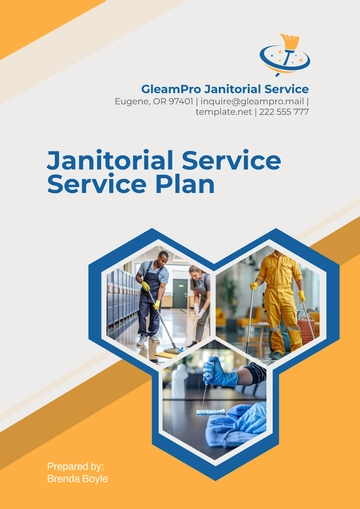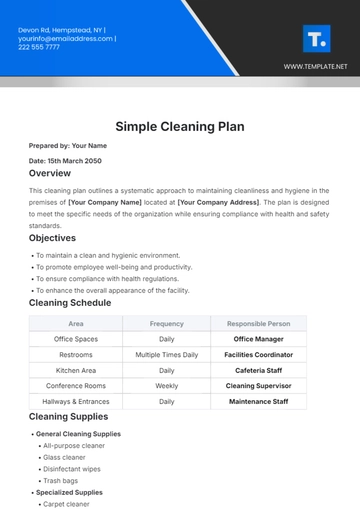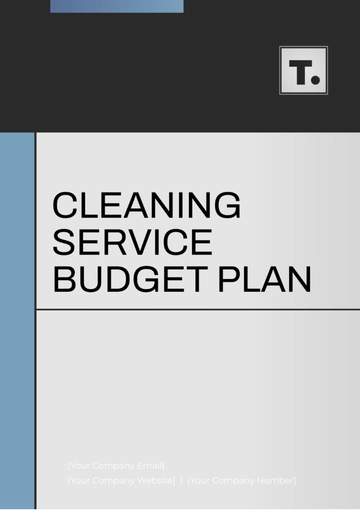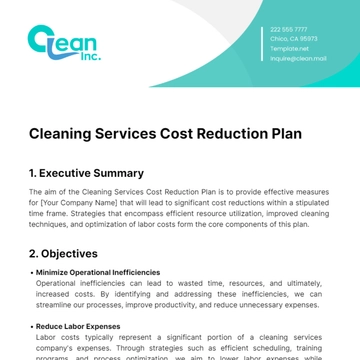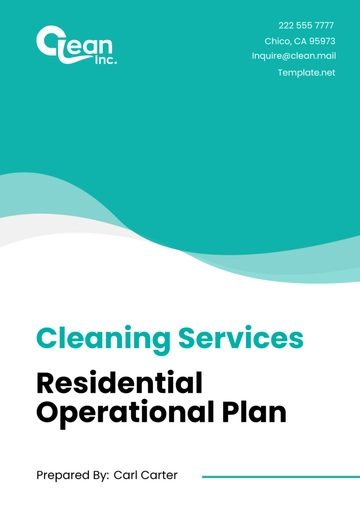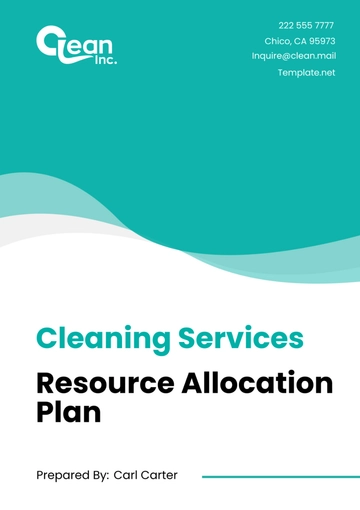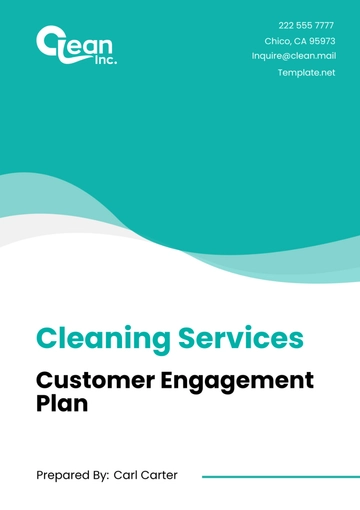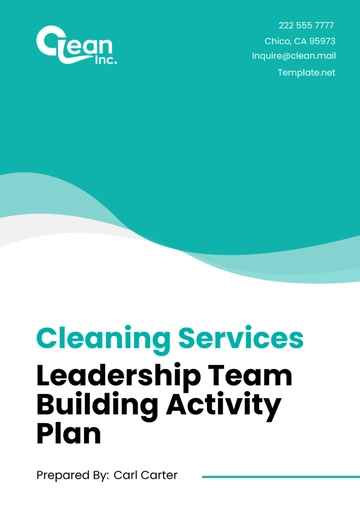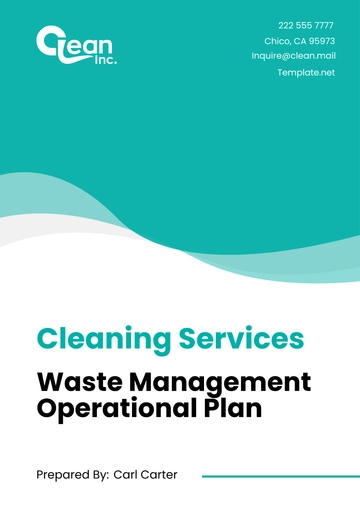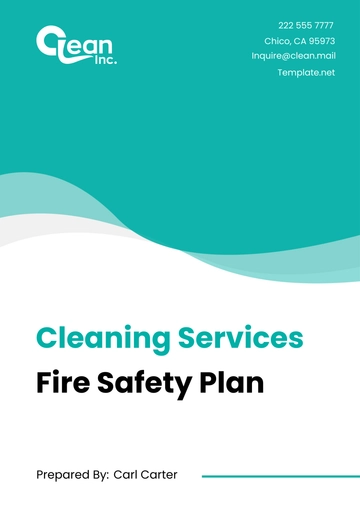Free Cleaning Services Leadership Team Building Activity Plan
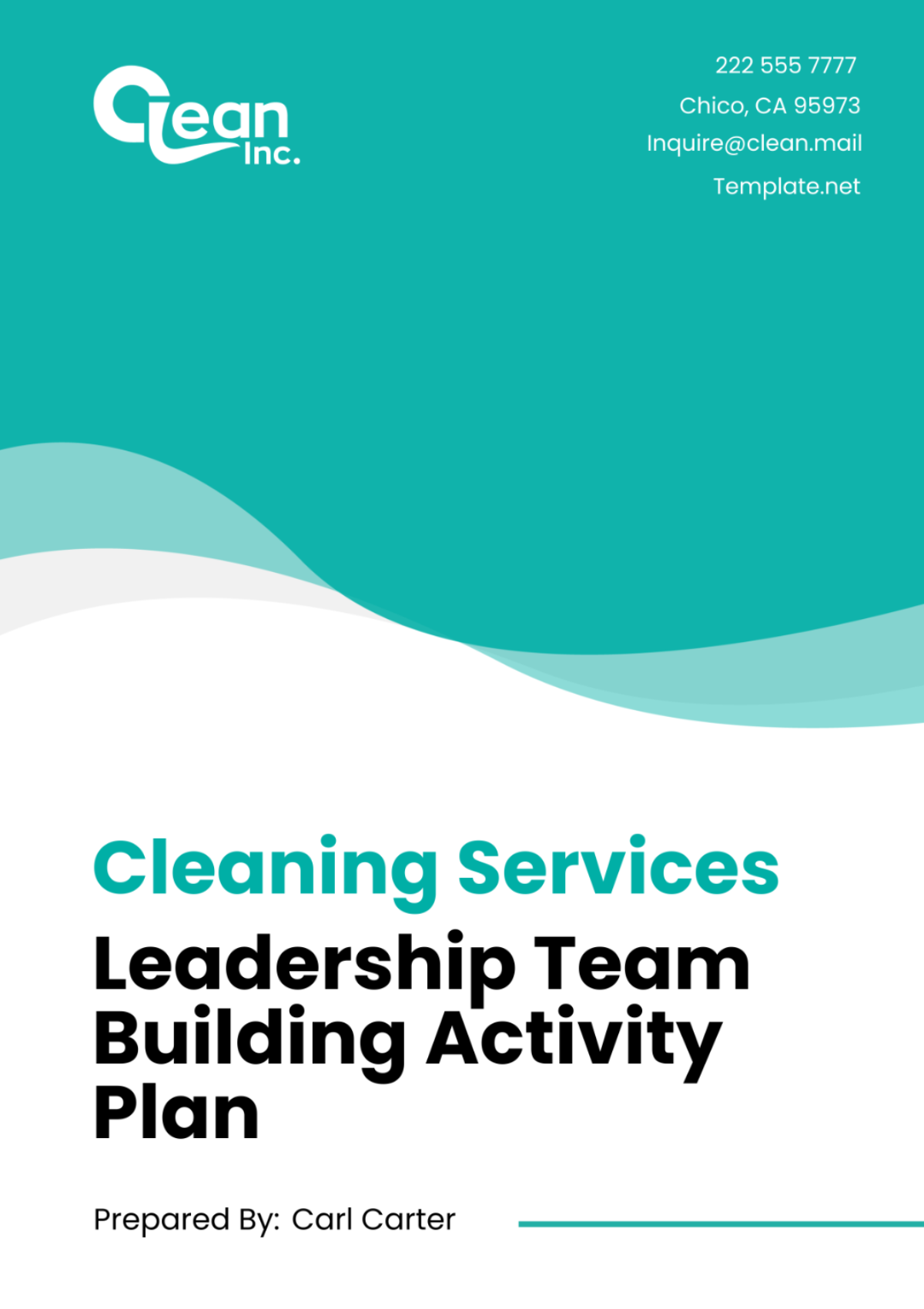
1. Introduction and Objectives
Welcome to the Cleaning Services Leadership Team Building Activity Plan. At [Your Company Name], we understand the vital role that teamwork and collaboration play in the success of our cleaning services company. This comprehensive plan aims to cultivate productive relationships within our leadership team, fostering an environment of trust, communication, and collaboration. By investing in team development, we aim to elevate our collective performance, thereby enhancing customer satisfaction and driving business growth.
Objectives
The primary objectives of this plan are to improve communication, enhance problem-solving skills, and build trust among members of our leadership team. Through targeted team-building activities, we seek to facilitate open and effective communication channels, empower team members to tackle challenges collaboratively, and establish a foundation of trust and mutual respect. By achieving these objectives, we aim to strengthen our team's cohesion and effectiveness, ultimately delivering exceptional service and value to our customers.
2. Team Assessment and Analysis
Before embarking on our team-building journey, it's essential to understand where we currently stand as a leadership team. This section involves a comprehensive assessment of our team's strengths and weaknesses to identify areas for improvement and development. By conducting a SWOT analysis, we can gain valuable insights into our internal capabilities and external challenges, enabling us to prioritize actions that will maximize our team's effectiveness and cohesion.
Strengths | Weaknesses | Opportunities | Threats |
|---|---|---|---|
Strong industry knowledge | Limited communication channels | Growing market demand | Intense competition |
Diverse skill sets | Lack of trust | Expansion into new markets | Technological disruptions |
Effective leadership | Inconsistent team performance | Potential for strategic partnerships | Economic instability |
Collaborative culture | Insufficient delegation | Rising trend towards sustainability | Regulatory changes |
3. Activity Selection
In selecting activities for our team-building program, we prioritize options that directly align with our overarching objectives of promoting teamwork, developing leadership qualities, and bolstering communication skills within our leadership team. Each activity is carefully curated to engage participants in meaningful experiences that facilitate learning and growth.
Potential activities include problem-solving exercises that encourage collaborative decision-making, role-playing scenarios to enhance leadership and interpersonal skills, and team challenges designed to foster creativity, innovation, and effective teamwork. By offering a diverse range of activities, we aim to cater to various learning styles and preferences while ensuring that each participant has the opportunity to contribute and grow.
4. Logistics and Planning
Logistics and planning are comprehensive fields that entail an array of critical elements. These elements incorporate the crucial tasks of selecting an appropriate date, determining the ideal time, as well as identifying and arranging the most suitable location.
Date | Time | Venue |
|---|---|---|
27th October | 2:00 PM - 5:00 PM | Corporate Training Room |
We will also ensure all necessary equipment and materials are well-prepared in advance.
5. Facilitation and Execution
In this section, we outline the critical role of the facilitator in orchestrating a successful team-building event and provide a detailed agenda to guide the execution of activities. The facilitator will serve as a guide and mentor, steering participants towards achieving the desired outcomes while fostering an inclusive and supportive environment for all team members.
Facilitator's Role | Event Agenda |
|---|---|
Lead activities and discussions to achieve objectives | Time Activity |
Ensure participation and engagement of all team members | 9:00 AM - 9:30 AM Welcome and Introduction |
Manage group dynamics and resolve conflicts effectively | 9:30 AM - 10:30 AM Problem-Solving Exercise |
Provide feedback and guidance throughout the event | 10:30 AM - 10:45 AM Break |
Keep the event on track and within the allocated timeframe | 10:45 AM - 12:00 PM Role-Playing Scenarios |
With a clear agenda in place, participants can anticipate the flow of the event and fully engage in each activity, maximizing the opportunity for learning and growth.
6. Reflection and Debriefing
After each activity, dedicated time will be allocated for reflection, allowing participants to express their thoughts, observations, and insights. These sessions provide an opportunity for individuals to share their perspectives, highlight successes, and identify areas for improvement. Facilitators will guide discussions to ensure that key takeaways are captured and understood by all team members.
Debriefing Session
At the conclusion of the event, a comprehensive debriefing session will be conducted to review overall outcomes and assess the effectiveness of the team-building activities. This session will offer participants the chance to reflect on their collective experiences, identify actionable insights, and discuss strategies for applying newfound knowledge and skills in their roles. Feedback gathered during the debriefing will inform future team-building initiatives and help to continuously enhance the effectiveness of our leadership team.
7. Follow-Up and Evaluation
In the coming week, a follow-up session will be conducted to further reinforce the learning and also provide an opportunity for discussion on how the newly learnt skills can be put into practical use. We highly value the feedback participants provide, and it will serve as a means for us to determine how effective the team-building activities were. This form of evaluation will be extremely beneficial and will inform the design of our future team-building events, allowing us to make necessary adjustments and improvements.
8. Communication Plan
Effective communication is the cornerstone of successful team-building initiatives. This section outlines our approach to ensuring that all team members are fully informed and engaged throughout the program. By utilizing various communication channels and methods, we aim to facilitate clear understanding, active participation, and collaboration among participants.
Objective and Purpose
Clearly define the purpose of the communication plan: to ensure all team members are fully informed about the objectives, roles, and expectations associated with the team-building program.
Emphasize the importance of clear and consistent communication in fostering engagement and participation among participants.
Channels and Methods
a. Email Communication
Regular updates will be sent via email to provide information about event logistics, agenda updates, and preparatory materials.
b. Team Meetings
Scheduled team meetings will serve as opportunities to discuss the team-building program, clarify roles, and address any questions or concerns.
c. One-on-One Sessions
Individual sessions will be conducted to provide personalized support, address specific concerns, and ensure that each team member understands their role in the program.
9. Risk Management
As we embark on our team-building journey, it's essential to proactively identify and mitigate potential risks that could impact the success of our program. This section outlines our commitment to ensuring a safe and enjoyable experience for all participants by implementing robust risk management strategies.
Anticipating Risks
Identify potential risks associated with the team-building activities, such as safety hazards, logistical challenges, or participant discomfort.
Assess the likelihood and potential impact of each risk to prioritize mitigation efforts effectively.
Mitigation Strategies
a. Safety Measures
Implement safety protocols and guidelines to minimize the risk of accidents or injuries during activities.
Provide necessary safety equipment and ensure that all participants are adequately trained in its use.
b. Logistical Planning
Conduct thorough logistical planning to anticipate and address any challenges related to transportation, venue setup, and equipment availability.
Establish contingency plans to address unexpected disruptions or changes in the schedule.
c. Participant Comfort
Take into account individual preferences and limitations when designing activities to ensure a positive and inclusive experience for all participants.
Encourage open communication and provide opportunities for participants to voice any concerns or discomforts.
10. Results and Achievements Review
This section serves as a critical reflection on the outcomes of our team-building efforts. By tracking improvements in key areas such as communication, trust, and problem-solving skills, we can assess the program's effectiveness and identify areas for further development within our leadership team.
Tracking Improvements
Monitor and document notable improvements resulting from the team-building activities, focusing on key areas such as communication, trust, and problem-solving skills.
Utilize both qualitative and quantitative metrics to provide a comprehensive assessment of the program's impact on team dynamics and performance.
Evaluation Metrics
Communication: Assess the effectiveness of communication channels and the frequency of open dialogue among team members.
Trust: Measure the level of trust and collaboration demonstrated within the team through surveys or feedback sessions.
Problem-Solving Skills: Evaluate the team's ability to identify and address challenges collectively, noting any observable improvements in problem-solving techniques.
- 100% Customizable, free editor
- Access 1 Million+ Templates, photo’s & graphics
- Download or share as a template
- Click and replace photos, graphics, text, backgrounds
- Resize, crop, AI write & more
- Access advanced editor
Foster team cohesion with the Cleaning Services Leadership Team Building Activity Plan Template from Template.net. This editable and customizable template is designed to outline engaging and productive team-building exercises for your leadership team. Editable in our Ai Editor Tool, it's key to enhancing collaboration, communication, and morale among your cleaning service's management staff.
You may also like
- Finance Plan
- Construction Plan
- Sales Plan
- Development Plan
- Career Plan
- Budget Plan
- HR Plan
- Education Plan
- Transition Plan
- Work Plan
- Training Plan
- Communication Plan
- Operation Plan
- Health And Safety Plan
- Strategy Plan
- Professional Development Plan
- Advertising Plan
- Risk Management Plan
- Restaurant Plan
- School Plan
- Nursing Home Patient Care Plan
- Nursing Care Plan
- Plan Event
- Startup Plan
- Social Media Plan
- Staffing Plan
- Annual Plan
- Content Plan
- Payment Plan
- Implementation Plan
- Hotel Plan
- Workout Plan
- Accounting Plan
- Campaign Plan
- Essay Plan
- 30 60 90 Day Plan
- Research Plan
- Recruitment Plan
- 90 Day Plan
- Quarterly Plan
- Emergency Plan
- 5 Year Plan
- Gym Plan
- Personal Plan
- IT and Software Plan
- Treatment Plan
- Real Estate Plan
- Law Firm Plan
- Healthcare Plan
- Improvement Plan
- Media Plan
- 5 Year Business Plan
- Learning Plan
- Marketing Campaign Plan
- Travel Agency Plan
- Cleaning Services Plan
- Interior Design Plan
- Performance Plan
- PR Plan
- Birth Plan
- Life Plan
- SEO Plan
- Disaster Recovery Plan
- Continuity Plan
- Launch Plan
- Legal Plan
- Behavior Plan
- Performance Improvement Plan
- Salon Plan
- Security Plan
- Security Management Plan
- Employee Development Plan
- Quality Plan
- Service Improvement Plan
- Growth Plan
- Incident Response Plan
- Basketball Plan
- Emergency Action Plan
- Product Launch Plan
- Spa Plan
- Employee Training Plan
- Data Analysis Plan
- Employee Action Plan
- Territory Plan
- Audit Plan
- Classroom Plan
- Activity Plan
- Parenting Plan
- Care Plan
- Project Execution Plan
- Exercise Plan
- Internship Plan
- Software Development Plan
- Continuous Improvement Plan
- Leave Plan
- 90 Day Sales Plan
- Advertising Agency Plan
- Employee Transition Plan
- Smart Action Plan
- Workplace Safety Plan
- Behavior Change Plan
- Contingency Plan
- Continuity of Operations Plan
- Health Plan
- Quality Control Plan
- Self Plan
- Sports Development Plan
- Change Management Plan
- Ecommerce Plan
- Personal Financial Plan
- Process Improvement Plan
- 30-60-90 Day Sales Plan
- Crisis Management Plan
- Engagement Plan
- Execution Plan
- Pandemic Plan
- Quality Assurance Plan
- Service Continuity Plan
- Agile Project Plan
- Fundraising Plan
- Job Transition Plan
- Asset Maintenance Plan
- Maintenance Plan
- Software Test Plan
- Staff Training and Development Plan
- 3 Year Plan
- Brand Activation Plan
- Release Plan
- Resource Plan
- Risk Mitigation Plan
- Teacher Plan
- 30 60 90 Day Plan for New Manager
- Food Safety Plan
- Food Truck Plan
- Hiring Plan
- Quality Management Plan
- Wellness Plan
- Behavior Intervention Plan
- Bonus Plan
- Investment Plan
- Maternity Leave Plan
- Pandemic Response Plan
- Succession Planning
- Coaching Plan
- Configuration Management Plan
- Remote Work Plan
- Self Care Plan
- Teaching Plan
- 100-Day Plan
- HACCP Plan
- Student Plan
- Sustainability Plan
- 30 60 90 Day Plan for Interview
- Access Plan
- Site Specific Safety Plan
